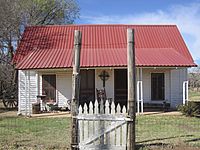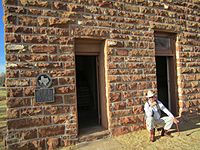Motley County, Texas facts for kids
Quick facts for kids
Motley County
|
|
|---|---|

Motley County Courthouse in Matador
|
|

Location within the U.S. state of Texas
|
|
 Texas's location within the U.S. |
|
| Country | |
| State | |
| Founded | 1891 |
| Seat | Matador |
| Largest town | Matador |
| Area | |
| • Total | 990 sq mi (2,600 km2) |
| • Land | 990 sq mi (2,600 km2) |
| • Water | 0.2 sq mi (0.5 km2) 0.03% |
| Population
(2020)
|
|
| • Total | 1,063 |
| • Density | 1.074/sq mi (0.4146/km2) |
| Time zone | UTC−6 (Central) |
| • Summer (DST) | UTC−5 (CDT) |
| Congressional district | 13th |
Motley County is a county located in the U.S. state of Texas. As of the 2020 census, its population was 1,063, making it the 10th-least populous county in Texas. Its county seat is Matador. The county was created in 1876 and organized in 1891. It is named for Junius William Mottley, a signer of the Texas Declaration of Independence. Mottley's name is spelled incorrectly because the bill establishing the county misspelled his name. Motley County was one of 30 prohibition, or entirely dry, counties in Texas, but is now a wet county.
Contents
History
Motley County was created on August 21, 1876, from Young and Bexar counties. It was organized on February 5, 1891. The large Matador Ranch, established in 1882 by a syndicate from Scotland and still operational after it was liquidated in 1951, is located in Motley and five adjoning counties.
The first white child in Motley County, Nora Cooper, was born in 1882 near what is the now ghost town of Tee Pee City, a camp operated by buffalo hunters and later the headquarters of the Texas Rangers under Captain G.W. Arrington from 1879 to 1881.
In 1913, the eight-mile long Motley County Railroad was chartered with money from more than ninety investors. It ran through unfenced ranch lands in the county before joining the Quanah, Acme and Pacific Railway at Roaring Springs. This track continued to operate until 1936.
In 1927-1928, Dr. Albert Carroll Traweek, Sr., an investor in the Motley Railroad, established the Traweek Hospital, which was turned over to the county in 1991 and became the Motley County Historical Museum.
Whiteflat
A section of Motley County called "Whiteflat" was named for the tall white needlegrass which covered the flat prairie land there. A post office was established at "Whiteflat" in 1890. At its height, the rural community had four grocery stores, three service stations and garages, two cafes, a hardware store, two gins, and three churches. A one-room school opened in 1890 and was replaced in 1908 by a four-room structure. In 1922, a two-story brick structure was erected for the Whiteflat School, which also served as the community gathering place. Whiteflat declined during the Great Depression and the Dust Bowl of the 1930s. The school closed in 1946 and was consolidated with those in Matador, eleven miles to the south. The churches disbanded in the 1960s. The post office closed in 1966 upon the death of the last postmistress, Ida Morriss. The remaining retail business, a grocery store and service station, closed in 1968.
Jail
The two-story county jail was erected in 1891, the year that Motley County was incorporated. County Judge Henry Harrison "Hank" Campbell (1840–1911) and the four county commissioners at the time awarded a construction contract to local builders J.F. Aiken and J.T. Cornett. Cells were on the top floor, and the jailers' living quarters were on the lower level. The first courthouse, also built in 1891, later burned, but the jail remained a symbol of Motley County's frontier heritage. The jail is undergoing renovation for historic preservation purposes.
Library
The Motley County Library has been housed since 1986 in the Moore Building, a brick structure constructed in 1916 after a fire swept through downtown Matador and destroyed wooden frame buildings. The Moore Building was previously a grocery store and a butcher shop. The library had been within the Matador school facilities until a tornado struck in 1984. With the help of a Meadows Foundation grant, the Moore Building was renovated so that it could house the library. An adjacent library annex building is used for storage, as a genealogical room, and for meetings and social events.
An historical mural at the library was painted on canvas by Joe Taylor of nearby Crosbyton, Texas. Taylor includes in the mural Quanah Parker at Roaring Springs, Judge Henry H. Campbell in his dugout prior to the establishment of the Matador Ranch, Dude Barton, an honoree of the National Cowgirl Hall of Fame in Fort Worth, and Shannon Davidson, a long-distance rider who won a Hollywood movie contract.
Geography
According to the U.S. Census Bureau, the county has a total area of 990 square miles (2,600 km2), of which 990 square miles (2,600 km2) is land and 0.2 square miles (0.52 km2) (0.03%) is water.
Major highways

 U.S. Highway 62/U.S. Highway 70
U.S. Highway 62/U.S. Highway 70 State Highway 70
State Highway 70
Adjacent counties
- Hall County (north)
- Cottle County (east)
- Dickens County (south)
- Floyd County (west)
- Briscoe County (northwest)
- King County (northwest)
Demographics
| Historical population | |||
|---|---|---|---|
| Census | Pop. | %± | |
| 1880 | 24 | — | |
| 1890 | 139 | 479.2% | |
| 1900 | 1,257 | 804.3% | |
| 1910 | 2,396 | 90.6% | |
| 1920 | 4,107 | 71.4% | |
| 1930 | 6,812 | 65.9% | |
| 1940 | 4,994 | −26.7% | |
| 1950 | 3,963 | −20.6% | |
| 1960 | 2,870 | −27.6% | |
| 1970 | 2,178 | −24.1% | |
| 1980 | 1,950 | −10.5% | |
| 1990 | 1,532 | −21.4% | |
| 2000 | 1,426 | −6.9% | |
| 2010 | 1,210 | −15.1% | |
| 2020 | 1,063 | −12.1% | |
| U.S. Decennial Census 1850–2010 2010 2020 |
|||
2020 census
| Race / Ethnicity | Pop 2010 | Pop 2020 | % 2010 | % 2020 |
|---|---|---|---|---|
| White alone (NH) | 1,013 | 858 | 83.72% | 80.71% |
| Black or African American alone (NH) | 24 | 7 | 1.98% | 0.66% |
| Native American or Alaska Native alone (NH) | 8 | 0 | 0.66% | 0.00% |
| Asian alone (NH) | 0 | 0 | 0.00% | 0.00% |
| Pacific Islander alone (NH) | 0 | 0 | 0.00% | 0.00% |
| Some Other Race alone (NH) | 0 | 2 | 0.00% | 0.19% |
| Mixed Race/Multi-Racial (NH) | 2 | 43 | 0.17% | 4.05% |
| Hispanic or Latino (any race) | 163 | 153 | 13.47% | 14.39% |
| Total | 1,210 | 1,063 | 100.00% | 100.00% |
Note: the US Census treats Hispanic/Latino as an ethnic category. This table excludes Latinos from the racial categories and assigns them to a separate category. Hispanics/Latinos can be of any race.
Communities
Towns
- Matador (county seat)
- Roaring Springs
Unincorporated communities
Ghost towns
See also
 In Spanish: Condado de Motley para niños
In Spanish: Condado de Motley para niños



